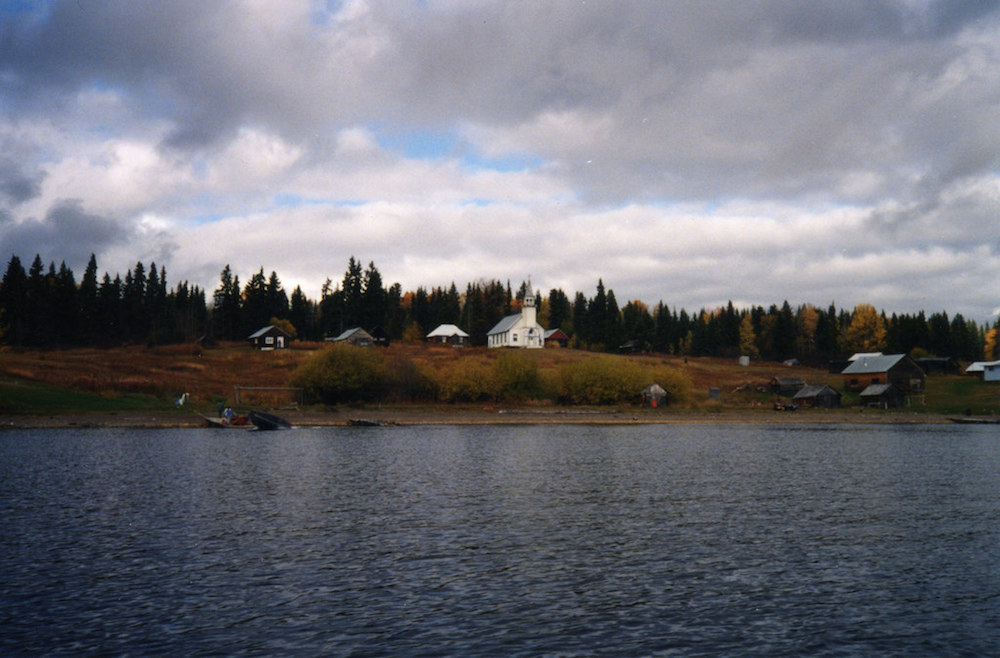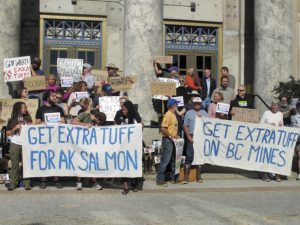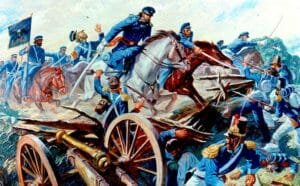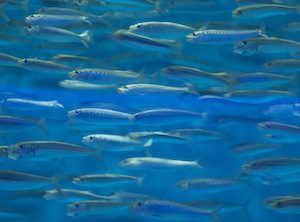For One Abuse Survivor, Investigation’s Door Is Sealed
A teacher was not allowed to testify at a hearing, and many other Canadians share her bitter disappointment in the way crimes against indigenous women and girls are being investigated. Old Fort Babine in British Columbia, Canada, in 1995. (Flickr / CC 2.0)
Old Fort Babine in British Columbia, Canada, in 1995. (Flickr / CC 2.0)
Editor’s note: Canada’s National Inquiry Into Missing and Murdered Indigenous Women and Girls is an independent commission whose mandate extends beyond cases of murder and missing persons. The inquiry says it seeks to examine “the systemic causes behind the violence that Indigenous women and girls experience, and their greater vulnerability to violence, by looking for patterns and underlying factors that explain why higher levels of violence occur.” The commissioners’ areas of interest include policing and child welfare.
Dorothy Williams, a 55-year-old teacher and grandmother, makes the Carrier language come alive in her classroom at Fort Babine—a small settlement of the Lake Babine First Nation, located down a logging road off Highway 16 in northern British Columbia, Canada. She has posted words in Carrier for the kids—seenyeen reads one of them. It means “Stand up.” Ideenneeyh means “You say it.” Those two phrases define much about who Williams is. She also teaches Carrier culture—drumming, singing, dancing and the preparation of traditional foods.
Standing up and speaking is something Williams is trying to do. In August, she contacted Canada’s National Inquiry Into Missing and Murdered Indigenous Women and Girls. The inquiry was a campaign promise of Prime Minister Justin Trudeau, whose Liberal Party won a landslide victory in 2015. The inquiry would not just examine how a large number of murders and disappearances of indigenous women and girls could take place with few legal consequences or investigations decade after decade across Canada. It also was called to address the violent crimes that indigenous women endure at a rate three times greater than nonindigenous women, often starting in childhood.
Williams wanted to tell the inquiry about the violence that beset young children at Immaculata Day School—the institution she and so many other Lake Babine members were forced to attend in Burns Lake, hundreds of kilometers from their traditional territories of Fort Babine and Old Fort. She wanted to talk about how Immaculata and Lejac Residential School—run by the Catholic Church and funded by the feds—embedded trauma, suicide and post-traumatic stress disorder deep within the community. Finally, she wanted to explain how, as a survivor, she was able—through “lots and lots of really good counseling”—to move beyond the pain. The only thing is, the inquiry appeared not to want to hear from her.
“Unfortunately, it has taken a great deal of correspondence to the inquiry, and I still have not been allowed to speak,” Williams told me. “It seemed that my request simply fell through the cracks. Indigenous women have had years of abuse, so when we finally hear of an inquiry that says it wants to hear from us, it is terribly disappointing to have to fight for this opportunity, and then still not have our voices heard.”
Her voice joins many others. On Aug. 8, dozens of families and survivors wrote to Trudeau, saying that the inquiry has “continually dismissed [their] concerns, refused to take steps to rebuild trust, and [has] maintained a deeply misguided approach that imposes a harmful colonial process.”
The government did not respond to the August letter.
By the time it is finished, the inquiry will have conducted hearings in nine areas. In late September one was held in Smithers, British Columbia, which happens to be the closest town to Fort Babine. But for Williams it would still have been a long and lonely drive down a muddy, potholed road to get there, and she could not be away from her students during school hours. There is no substitute teacher, and even if a replacement could have been arranged, finding someone able to teach Carrier would have been very unlikely. Williams informed the inquiry that she needed to speak at the end of the day, and waited to hear back.
Williams waited in vain. There was no reply to her August email. As the date of the inquiry approached, she reached out again. Finally, on Sept. 23, as she was leaving the funeral of a former student from Immaculata in Burns Lake, an outreach employee contacted her. Williams told her she was ready to speak about the impact of the abuse at Immaculata and the shadow it cast. She just needed to know when.
For reasons the inquiry will not explain beyond saying “there’s a process,” Williams was never put on the speaker list. No one from the inquiry even called her before the hearing was held. She was left waiting for the phone to ring. Now, Williams says, she “will have nothing to do with the inquiry,” which is continuing to gather evidence across Canada. The inquiry commission will hold periodic hearings—in areas far removed from Lake Babine—into December and write a final report next year.
Smithers is on Highway 16, also known as the Highway of Tears because of the number of indigenous women and girls who have either been murdered or gone missing along its roughly 445 miles. Recorded cases of the murdered and missing date back to 1969, but families say the Royal Canadian Mounted Police has been quick to pronounce many deaths accidents or suicides. Critics often have alleged bias among investigators.
It is as if the entire area, beautiful as it is, is shrouded in pain—a place where colonialism and zealous Catholicism came together with disastrous consequences. The church even changed the name of Williams’ nation from Nedut’en, meaning “People That Live Further Up,” to “Babine,” French derogatory slang for an animal-like or swollen lip. [Editor’s note: One source says the French originally gave that name to the people they encountered in the area because some of the women wore a wood plug that distended the lower lip.]
This resource-rich land and the first people on it were up for grabs as multinational corporations and missionaries claimed control. Every weekend when Williams drives the three to five hours—depending on weather—to Burns Lake to see her family, she must purchase drinking water. Lake Babine and the tributaries feeding it reflect the ravages of over a century of resource extraction. The irony of needing to import water into the traditional territory of a people whose history and understanding of themselves are based on their relationship to water, and what it provides, speaks only briefly to their wrath over colonialism. Added to that wrath is anger over a deeply entrenched conservative church that operated 13 schools where predators—most often with no training in education—had free range.
Williams remembers an evening in the early 1980s in Burns Lake. “We were sitting at a round table with my six sisters,” she says. “It was the first time any of us talked about the abuse we endured as kids—what had happened to us emotionally, physically, sexually. Even though we all saw each other being physically, emotionally and verbally abused at school, we didn’t talk about it until then. After a while, it was as if it was a normal way of living as kids—that we would be abused. We all went through it. We opened up about the deep hurts for the first time.”
In her statement for the inquiry, she wrote, “For many years I carried a great deal of pain around inside me, I avoided getting help, but then I started realizing if I didn’t seek help I would become like my abusers—living in a state of denial, resentment, self-blame and anger. Luckily, despite years of abuse, I was still able to hear a voice inside me that told me I didn’t deserve any of this. Counseling and education—first becoming educated and then becoming an educator—put me on a path of healing and finding my inner-voice that said, ‘Hey, you’re not a bad person.’ ”
She observed the cyclical nature that sexual violence brought to her community through the residential and day schools of the Catholic Church. “It appears it was inescapable,” her statement says. “Victims of sexual violence at Lejac Residential School became victimizers in our community. Abuse of children became normalized through the Catholic School system. For instance, people in our community attended Immaculata Day School. Canada has heard about the daily abuse residential school students endured, but those of us who attended day schools also endured terrible abuse. I attended from 1967 as a kindergarten student to 1972. We were forced to go to school. We did not want to go. It was scary. We didn’t know where we were going. We did not know English and were put in among white teachers and nuns—none of whom spoke Carrier.”
“As girls, we learned that if men such as priests and missionaries could abuse us, then anyone could, because they were held up in high-esteem,” Williams’ statement continues. “This made it acceptable for abuse to take place in our homes and relationships.”
In addition to chronicling severe abuse, Williams’ statement asks questions that make Canadians very uncomfortable. “To this day I cannot figure out what we did that was so bad. Others applied for compensation, but Immaculata was not classified as a residential school. I do not want money. What we went through as kids is not going to change if we are given money. What was done to us already happened. I want justice.” Why, she asks, were such things done to her people? Because the abusers were white and her people are native? “But we have the same blood and breathe the same air,” she writes.
“Our memories are not false—they are very real. The [Royal Canadian Mounted Police] never interviewed me about horrible violence towards children. It seems we’re still just ‘heathens’, ‘dirty kids.’ … Five years have passed since people started telling their stories. … No one—not the government, or the RCMP did anything except protect [abusers]. It really doesn’t matter how much we change if those who commit violence against Indigenous women, and those who are supposed to investigate violence against Indigenous victims have not changed.”
On Oct. 7, the lead lawyer, a respected expert specializing in sexual assault law, left the inquiry, while its director of research gave notice that she would be leaving as of Nov. 1. By Oct. 10, 180 people had signed a letter to Trudeau asking for the resignation of all the inquiry’s commissioners and a complete restart.
After facing a closed door at the Smithers hearing, Williams is left deeply disappointed. “For me to be ignored after what we went through at Immaculata—not just the women, but the men were abused as boys, too—I felt not important. What happened to us didn’t matter. How long have we waited? Yes, we weren’t murdered, but our stories are just as important as any others, and they didn’t want to hear them.”
Laura Robinson has written six books on sports and in 1992 was the first Canadian journalist to write about sexual abuse in sports. She has worked on award-winning films that address equity and power in sports, including “Crossing the Line” and “On Thin Ice.” In 2015, the Truth and Reconciliation Commission on Indian Residential Schools cited her work in its report to the Canadian government.
Your support matters…Independent journalism is under threat and overshadowed by heavily funded mainstream media.
You can help level the playing field. Become a member.
Your tax-deductible contribution keeps us digging beneath the headlines to give you thought-provoking, investigative reporting and analysis that unearths what's really happening- without compromise.
Give today to support our courageous, independent journalists.





You need to be a supporter to comment.
There are currently no responses to this article.
Be the first to respond.